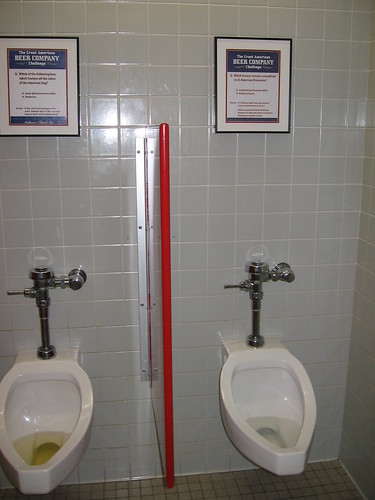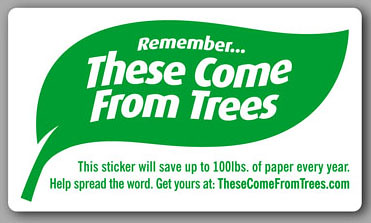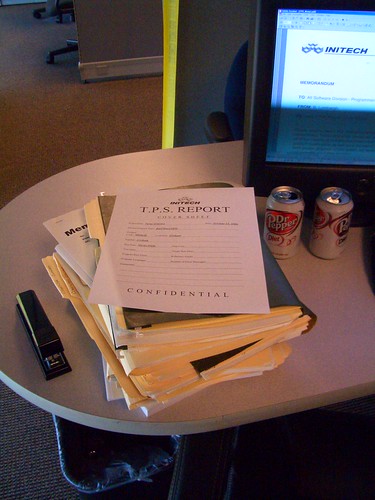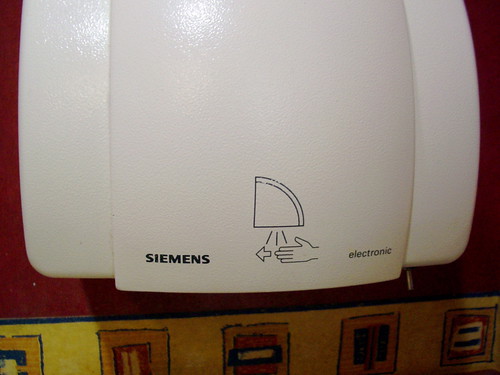Because I'm a recovering grammar nazi, and all around writing wonk, I kinda nerd out on effective versus ineffective communication. It's one of the things that makes me laugh, and enjoy life that much more.
For example, on the theme of bathrooms, those signs posted above sinks or paper towel dispenser that say "Washing your hands is good for your health, and required by law for employees". Those signs crack me up, because they're great signs, in the totally WRONG PLACE.

In that I'm a guy, I'll look at this from the male user's perspective: the decision of whether or not to wash your hands--the very decision that sign is trying to influence--isn't made at the sink!

If you're at the sink, guess what, you've already been convinced! It's called preaching to the choir. If the sign-posters really wanted to affect hand sanitation, they'd post those signs over each urinal and the backs of stall doors, where I have nothing else to read! The advertisers have certainly already figured it out....
Anyway, so that's an example of BAD textual communication. Right message, wrong context. But what makes me even happier than the giggles out of seeing bad examples of communication is finding really GOOD ones.
And I had a feeling that the
right message in the
right context could be helpful reducing "costless" paper waste (more on "costless" in another post) that I had been paying attention to lately.
As such I figured that the message had a couple requirements:
 1.It needed to be friendly.
1.It needed to be friendly. No one likes to be lectured. In the situations where I saw this message being deployed, the relationship is between a customer and service provider, and most customers don't like to be lectured. Further, because this was likely going to be a guerrilla message--not sanctioned, at least initially--by the "bathroom owner" the message needed to be costless to him too, and not insult his customers. That picture was taken at SFO, where even the bathroom signs display the dictatorial tone only possible by a government agency or other massive monopolist. Ick.
 2. It needed to be portable.
2. It needed to be portable. The collective action issue of having to convince, say, the VP of Operation for Starbucks, or whatever, was too much for a side project like this. Also, going to Kimberly Clark or Georgia Pacific (paper manufacturers) was going to be a non-starter--you think they want to see their sales fall? No. So this message would likely need to be added to a paper dispenser by a viral agent--you, me, whoever. That means that it had to be smallish, so you could carry it around and stick them on appropriate. This pointed towards stickers. Just as portable as graffiti, but nicer looking. Which leads us to...
 3. It needed to look nice.
3. It needed to look nice. Because these messages were going to be hosted in a venue that was "owned" by someone who wasn't the message transmitter (the good samaritan who posted the sticker), there was a duty on our part to make sure that the message didn't create problems. Again, we were shooting for joint value here: the only results for the bathroom owner should be that his paper towel costs fall, and he gets to feel like he's doing his part to help conserve resources. As such, we figured that a nice, well-designed sticker, with nice colors would be the right way of going about this.
 4. It needed to be memorable.
4. It needed to be memorable. We needed the message itself to be "sticky", to add to its propensity to stay with the reader even after he left the place where he read it. So we shot for something that had a rhyme to it.
 5. It needed a viral call to action.
5. It needed a viral call to action. We already pointed out two audiences that the message needed to serve: 1. People using paper products and 2. the bathroom/venue "owner." But there was a third audience too: people who would be interested in helping with this project on their own, beyond using one less paper towel. This meant that we needed a viral call to action on the sticker. Something that told people why this was important, that their help was requested, and what their next step was if they chose to do so.

Ultimately, what we came up with is what you see above. We settled on a paper roll label as the most cost effective and portable medium to use, which would allow a well-designed, visually appealing message, in a mass-produce-able format. Vinyl stickers are too costly $.25-$.50 each just to buy, and are hard to get off (if someone really wants to remove the sticker, we don't want to make it terrible for them to do so).
We decided on the "These come from trees" message in that it evoked the value we wanted communicated to the viewer: using less of these helps save big, leafy, natural things. Its internal rhyme was nice, and had nice alliteration too. It hints at why the user might want to think about how much paper they're consuming, but it doesn't TELL them in a nasty "USE ONLY WHAT YOU NEED, YOU'RE A BAD PERSON IF YOU USE PAPER" fashion. I'd seen messages like that, and they're just gross. This was trying to be helpful, and non-judgmental. Kinda like a friend warning you just before you step in a puddle.
As for the viral call to action, we figured there was no better way than to leverage the memorable "These come from trees" than to buy the thesecomefromtrees.com domain, and use that as the pivot point for this project.
Hence, as you can see, it's a blog, with pictures from people who have stuck stickers and snapped pics of them, and more. It also provided the venue whereby people could buy stickers to help promote the message. $.20 per sticker, each of which saves a tree's worth of a paper a year (more on that statistic later).
So that was the design process behind the These Come From Trees sticker. We're still evaluating to make sure it's the best way for everyone involved (paper users, sticker stickers, and venue owners) to get the message out, and we're always open to comments!




























